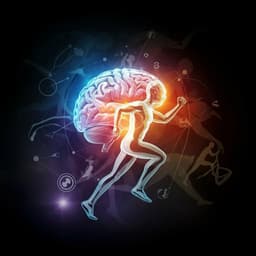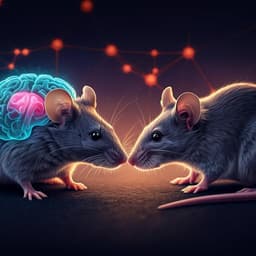
Medicine and Health
(R)-ketamine restores anterior insular cortex activity and cognitive deficits in social isolation-reared mice
R. Yokoyama, Y. Ago, et al.
This groundbreaking study by Rei Yokoyama and colleagues reveals how (R)-ketamine could potentially combat social cognitive deficits in those facing chronic social isolation. By uniquely activating the anterior insular cortex, (R)-ketamine offers hope for improving mental health outcomes where traditional treatments may fall short.
~3 min • Beginner • English
Introduction
The study addresses how chronic social isolation leads to social cognitive dysfunction and depressive-like behaviors and investigates the neural mechanisms by which ketamine enantiomers ((R)- and (S)-ketamine) may ameliorate these deficits. Prior work implicates the insula and prefrontal cortices in maintaining social cognition. Although racemic ketamine shows rapid antidepressant and pro-cognitive effects, the relative efficacy and mechanisms of its enantiomers remain unclear. The authors hypothesize that (R)-ketamine engages distinct neural circuits, potentially within the anterior insular cortex (aIC), to restore social cognition impaired by isolation stress.
Literature Review
Background evidence indicates that both juvenile and adult social isolation negatively affect mental health and social cognition. Rodent isolation models (>2 weeks) reduce sociability and alter behavior. Racemic ketamine rapidly alleviates depressive symptoms and can improve cognition; proposed mechanisms include prefrontal neuroplasticity, BDNF–TrkB signaling, and modulation of stress-induced neural activity. Enantiomers differ biochemically and pharmacologically: (S)-ketamine is a stronger NMDA receptor antagonist; (R)-ketamine exhibits distinct frontal cortical effects and less dopaminergic activation. However, how these differences translate to circuit-level and behavioral outcomes, particularly in social cognition, remains unresolved.
Methodology
Animals: Mice were reared either in groups or under chronic social isolation from weaning. Behavioral assays included the forced swim test (FST), three-chamber social interaction tests (performed twice: a saline baseline day followed by drug treatment day), and a 5-trial social memory paradigm with a novelty trial.
Drug treatments: Subanesthetic (R)- and (S)-ketamine were administered intraperitoneally at 10 or 20 mg/kg. For DREADD experiments, clozapine-N-oxide (CNO) was given (inhibition: 5 mg/kg; activation: 1 mg/kg) 30 min prior to behavioral testing or ketamine as appropriate. ANA-12 was used to inhibit TrkB in pharmacological probing.
Brain-wide IEG mapping: Arc-dVenus reporter mice were used. Mice were perfused and brains collected 5 h post-test. Whole-brain subcellular-resolution imaging was conducted with the FAST system. c-Fos/dVenus-positive cells were quantified across semi-automatically parcellated brain areas (22 areas for z-scored datasets; counts also reported across 72 regions). Group datasets (saline, (S)-ketamine, (R)-ketamine; n = 5/group) were z-scored and analyzed via linear SVM classification (caret in MATLAB R2022a). Classifier weights were converted to activation patterns to identify regions discriminating (R)-ketamine from saline or (S)-ketamine.
Viral tools and surgeries: AAVdj vectors under CaMKIIα promoter were used to express hM4Di-mCherry (inhibitory DREADD), hM3Dq-mCherry (excitatory DREADD), mCherry control, or GCaMP6f for photometry in the aIC. Stereotaxic injections targeted the insular cortex/aIC (e.g., +2.1 AP, −2.6 ML, −3.7 DV; or +1.2 AP, −2.6 ML, −3.5 DV relative to bregma), with 250 nL per side for DREADDs at ~10^12–10^13 vg/mL. Fiber-optic cannulae were implanted for photometry. Postoperative care included buprenorphine and gentamicin with ≥3 weeks recovery.
Fiber photometry: Unilateral aIC GCaMP6f expression with wireless photometry headstage (470 nm excitation). Signals were synchronized to behavior, baseline-corrected, smoothed, and z-scored relative to a 5-min baseline. Event-triggered analyses compared mean z-scores in 3 s post-contact windows for object versus mouse interactions.
Electrophysiology: Whole-cell voltage-clamp in aIC pyramidal neurons from slices assessed direct current changes at −80 mV during (R)-ketamine application.
Statistics: Variance tested by Levene’s test. Group comparisons used one- or two-way ANOVA (including repeated measures when applicable) with Tukey, Bonferroni, Holm–Sidak, or Dunnett post hoc tests. Two-group comparisons used unpaired or paired t-tests. Spearman’s correlations assessed associations. Alpha set at p < 0.05.
Key Findings
- FST antidepressant-like effects: In both group- and isolation-reared mice, (R)-ketamine (10 and 20 mg/kg) and (S)-ketamine (20 mg/kg) acutely reduced immobility 30 min post-dose. At 7 days post 20 mg/kg dosing, reductions persisted for both enantiomers.
- Brain-wide activity mapping: Linear SVM on z-scored IEG data identified the insular cortex (IC), anterior cingulate cortex (ACC), and premotor cortex as key contributors discriminating (R)-ketamine from saline and (S)-ketamine, with the IC showing the strongest contribution versus saline. (R)-ketamine significantly increased dVenus-positive cells in the anterior IC region (+2.50 to +1.45 mm AP from bregma). Reported ANOVA for IC distribution showed significant treatment and spatial effects (e.g., spatial distribution F(9,120) ≈ 2.83, p < 0.05; additional two-way ANOVA with strong treatment effect, p < 0.0001).
- aIC necessity for behavioral effect: Chemogenetic inhibition of CaMKIIα-positive aIC neurons (hM4Di + CNO) attenuated the (R)-ketamine-induced reduction in FST immobility, indicating aIC involvement in (R)-ketamine’s action. Two-way ANOVA showed significant effects (e.g., F(2,37) = 6.198, p = 0.0041). In contrast, the (S)-ketamine effect on immobility was not sensitive to aIC inhibition under these conditions.
- aIC activation and social investigation: Fiber photometry revealed that isolation-reared mice exhibited blunted aIC responses to social contact under saline. After 20 mg/kg (R)-ketamine, aIC activity increased significantly upon contact with a novel mouse compared to an object, and the magnitude of aIC activation correlated positively with subsequent mouse-contact duration. Group-reared mice showed robust aIC responses to mouse versus object already under saline. (S)-ketamine did not produce comparable enhancement of social contact-evoked aIC activity in isolation-reared mice.
- Social memory: In a 5-trial social memory test with a novelty probe, isolation-reared mice showed impaired social memory and low investigation times under saline on the first session. In a second session, (R)-ketamine-treated isolation-reared mice showed increased novelty investigation (5th to 6th trial; e.g., 65.67 ± 14.33 s to 129.37 ± 13.70 s) and an enhanced trial-dependent decline in investigation toward the familiar mouse, indicative of improved social memory. Chemogenetic aIC inhibition offset these (R)-ketamine-mediated improvements.
- Mechanistic probes: Whole-cell recordings at −80 mV showed no direct (R)-ketamine current changes in aIC pyramidal neurons, suggesting effects are not via direct ligand-gated conductance at rest. Pharmacological TrkB blockade with ANA-12 did not diminish (R)-ketamine’s enhancement of aIC responses during social contact, suggesting BDNF–TrkB signaling is not required for this specific restoration of aIC function.
Discussion
The findings support that (R)-ketamine preferentially engages the anterior insular cortex to restore social cognition disrupted by chronic isolation. Enhanced aIC activation during social contact predicts increased social interaction, and chemogenetic data indicate aIC activity is necessary for (R)-ketamine’s pro-cognitive and some antidepressant-like effects. Brain-wide mapping implicates additional regions such as ACC and claustrum, consistent with the salience network’s role in processing socially relevant stimuli. These circuit-level effects may distinguish (R)- from (S)-ketamine mechanisms. Clinical observations that ketamine modulates insular activity and salience network connectivity align with the present results, suggesting translational relevance for treating social cognitive deficits. The work refines the understanding that restoration of aIC function, rather than BDNF–TrkB-dependent mechanisms in aIC, underlies (R)-ketamine’s rapid improvement in social cognitive phenotypes in isolation-reared mice.
Conclusion
(R)-ketamine uniquely activates the anterior insular cortex, restoring social contact-evoked neural responses and improving social memory in social isolation-reared mice. Inhibiting aIC neurons abolishes these benefits, establishing a causal role for aIC activity in (R)-ketamine’s pro-social cognitive effects, while (S)-ketamine does not show comparable aIC-dependent restoration. These results highlight a circuit mechanism, involving the salience network, by which (R)-ketamine may ameliorate social cognitive deficits. Future work should map precise aIC downstream pathways (e.g., ventral striatum/accumbens projections), dissect cell-type and synapse-specific mechanisms, and evaluate generalization across sexes, developmental stages, and additional models and doses.
Limitations
The brain-wide activity mapping identified responsive regions but did not fully resolve the anatomical and functional interconnections among them, limiting mechanistic interpretation at the circuit level. The reliance on DREADDs (CNO-based) may introduce off-target considerations. Studies were conducted in mice under specific isolation-rearing timelines with modest sample sizes, and electrophysiology assessed limited conditions, leaving synaptic and network mechanisms incompletely defined. Further experiments are needed to detail connectivity and causality across aIC-associated circuits.
Related Publications
Explore these studies to deepen your understanding of the subject.







